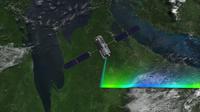 Fossil fuel combustion, deforestation, and
other human activities are adding almost 40 billion tons of carbon dioxide (CO
2
)
to the atmosphere each year. This is
enough CO
2
to increase the atmospheric concentration of this gas by
1% per year. Interestingly, less than half of this CO
2
stays
airborne, on average. The rest is
absorbed by natural processes (“sinks”) at the surface, whose identity and
location are poorly understood.
Fossil fuel combustion, deforestation, and
other human activities are adding almost 40 billion tons of carbon dioxide (CO
2
)
to the atmosphere each year. This is
enough CO
2
to increase the atmospheric concentration of this gas by
1% per year. Interestingly, less than half of this CO
2
stays
airborne, on average. The rest is
absorbed by natural processes (“sinks”) at the surface, whose identity and
location are poorly understood.
The Orbiting Carbon Observatory–2 (OCO-2) is NASA’s first satellite designed to study the sources and sinks of CO 2 . OCO-2 was successfully launched on July 2, 2014 and records almost a million measurements over Earth’s sunlit hemisphere each day. Observations recorded over the first 2 years of operation clearly show the most robust features of the atmospheric carbon cycle, including the intense northern hemisphere spring drawdown, as land plants rapidly absorb CO 2 to form new leaves, stems, and roots. They also show enhanced CO 2 over regions with intense fossil fuel combustion, such as the east coasts of China and the U.S. and provide a high resolution global description of the atmospheric CO 2 response to the intense 2015 El Niño. As these measurements are analyzed by the carbon cycle science community, they are expected to reveal far more detail about the processes controlling the atmospheric CO 2 buildup. This talk will describe the OCO-2 mission, summarize its measurement approach, and present results from its first 18 months in operation.
Download event poster PDF format

